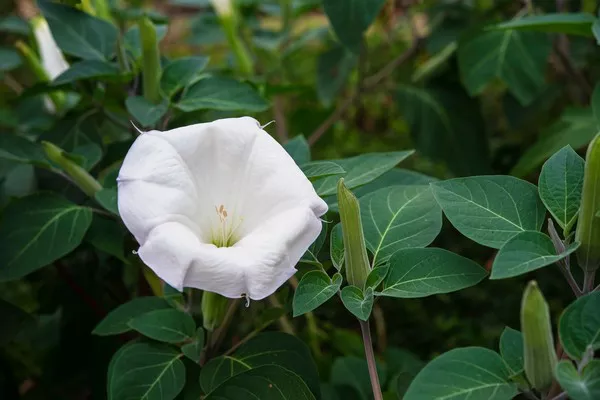Moonflowers, known for their enchanting evening blooms and intoxicating fragrance, have captured the fascination of gardeners and flower enthusiasts alike. But what about their early stages of growth? What do moonflower sprouts look like? In this comprehensive guide, we’ll delve into the appearance of moonflower sprouts and explore cultivation, care, and the symbolism of these unique plants.
1. Moonflower Basics: A Brief Introduction
Before we dive into the appearance of moonflower sprouts, it’s essential to understand the fundamentals of these captivating vines:
Scientific Name: Moonflowers belong to the Ipomoea genus, with the most common species being Ipomoea alba or Ipomoea muricata.
Blooms: Moonflowers produce large, white, or creamy-white flowers that open in the evening and close at dawn, releasing a sweet, intoxicating scent.
Growth Habit: Moonflowers are fast-growing annual or perennial vines that climb using twining stems and heart-shaped leaves.
2. What Do Moonflower Sprouts Look Like?
Moonflower sprouts, in their early stages of growth, have distinct characteristics that set them apart:
Cotyledons: Moonflower sprouts initially develop two cotyledon leaves, which are typically oval or heart-shaped and appear pale green.
First True Leaves: After the cotyledons, moonflower sprouts produce their first true leaves, which are deeply lobed and can resemble miniature versions of the mature moonflower leaves. These true leaves are also bright green.
Stems: Moonflower sprouts have slender, delicate stems that exhibit a subtle twining behavior, even at this early stage.
Roots: Below the soil surface, moonflower sprouts develop a network of fibrous roots that support their rapid growth.
Size: Moonflower sprouts are relatively small at this stage, typically measuring a few inches in height.
3. Germination and Growth Conditions
Understanding what moonflower sprouts look like is only part of the equation. To cultivate healthy moonflower plants, it’s crucial to provide the right growing conditions:
Soil: Moonflowers thrive in well-drained, fertile soil. A sandy loam or loamy soil mix with good aeration is ideal.
Sunlight: These sun-loving plants require full sun exposure for at least six hours a day to flourish.
Temperature: Moonflowers are sensitive to cold temperatures and should be planted outdoors after the last frost date in your region.
Watering: Keep the soil consistently moist but not waterlogged. Overwatering can lead to root rot.
Spacing: When planting moonflower seeds or transplants, ensure proper spacing to allow for their climbing habit.
4. Moonflower Care Tips
To nurture healthy moonflower sprouts into mature, blooming vines, follow these care tips:
Support Structures: Install trellises, fences, or other support structures for the vines to climb. Moonflowers can grow vigorously and benefit from vertical support.
Fertilization: Use a balanced, slow-release fertilizer to promote growth and blooming. Avoid excessive nitrogen, which can lead to lush foliage at the expense of flowers.
Pruning: Prune moonflower vines as needed to manage their growth and shape. This can help maintain a tidy appearance and encourage more prolific flowering.
Pest and Disease Control: Keep an eye out for common garden pests like aphids and caterpillars, as well as fungal diseases. Promptly address any issues with appropriate treatments.
5. Moonflowers in Symbolism and Culture
Moonflowers hold cultural significance and symbolism in various parts of the world:
Nocturnal Beauty: Moonflowers are often associated with the moon due to their evening blooms. In many cultures, they symbolize the beauty and mysteries of the night.
Spirituality: Some cultures view moonflowers as sacred and believe they have spiritual significance, representing purity, enlightenment, and transformation.
Medicinal Uses: Moonflowers have been used in traditional medicine for their potential sedative and analgesic properties. However, caution is advised, as some parts of the plant are toxic.
Love and Romance: In Victorian flower language, moonflowers are sometimes associated with love and romantic intentions.
6. Moonflower Varieties
Moonflowers come in different varieties, each with unique characteristics:
Ipomoea alba: The common moonflower variety, known for its large, fragrant white blooms.
Ipomoea muricata: Also called the “pink moonflower,” this variety produces pink or lavender-hued flowers.
Ipomoea tricolor: Known as the “heavenly blue,” this variety features striking, deep blue blossoms.
Conclusion
Moonflowers, with their captivating evening blossoms and elegant vines, add a touch of magic to gardens and landscapes. Understanding what moonflower sprouts look like is just the beginning of the journey into the world of these enchanting plants. By providing the right growing conditions, care, and support, you can watch these sprouts transform into a stunning display of moonlit beauty that is sure to enchant anyone who beholds them. So, whether you’re drawn to their symbolism, their fragrance, or simply their ethereal allure, moonflowers are a nighttime marvel that holds a special place in the world of flowers and gardening.


